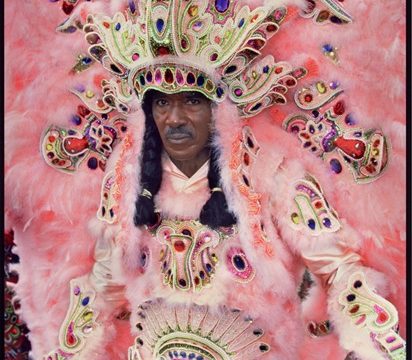
Image Credit: Michael Smith
Big Chief Allison “Tootie” Montana

Image Credit: Michael Smith
Chief Allison “Tootie” Montana was the Big Chief of the Yellow Pocahontas Mardi Gras Indian Tribe and “Chief of Chiefs,” the acknowledged leader of all the New Orleans tribes, for many years. A deeply respected, even revered, figure, he is credited with ushering in a new era of peace and nonviolence in the Mardi Gras Indian cultural tradition in New Orleans. By emphasizing the beauty and grandeur of the tribes with their colorful parades and astonishing costumes, Montana played a key role in preserving and sustaining one of New Orleans’ most distinctive cultural traditions for future generations.
The Mardi Gras Indian tradition has its roots in antebellum New Orleans. Escaped slaves would seek refuge outside the city among the Native American tribes of the region, who would give them asylum and keep them hidden and offer them protection. Tales of the Native Americans’ kindness and humanity quickly became legend among the African-American community in New Orleans and soon led to the practice of dressing up in colorful, feathered costumes, chanting and dancing as “Indians.” Thus the Mardi Gras Indian tradition—which to the uninitiated may appear to be a disrespectful display, but is in fact a symbol of profound respect—sprang from that early connection between two oppressed segments of American society.
For years, however, the public face of the Mardi Gras Indians was one of violence. The tribes adopted a gang-like mentality and accordingly became ensnarled in attacks and counter-attacks upon one another, creating a seemingly never-ending cycle of violence and retribution that became an ingrained part of the culture.
Tootie Montana’s life’s work was threefold: first, a passionate and ongoing plea to change that culture of violence; second, seeking to emphasize the beauty and celebratory nature of the Mardi Gras Indian tradition; and third, a sustained push to increase the visibility and respectability of the culture in the eyes of the establishment in the hopes of sustaining and preserving it.
Under Montana’s leadership, the Mardi Gras Indian tribes found their way back to their original mission of celebration, music and dance. Today, the tribes attempt to out-dress each other rather than fight, focusing on music, costumes and dancing. Tribe members work on their costumes year-round and rehearse diligently for months in preparation for events such as Mardi Gras, St. Joseph’s Day, and “Super Sunday.” The parades of the Mardi Gras Indian tribes are renowned throughout the world as some of the most dazzling spectacles to take place in New Orleans, as the Indians show off their feathered finery and make their way through the streets to the beat of drums and tambourines, chanting and clapping.
Montana was born in New Orleans on December 16, 1922. His father, Alfred, was Big Chief of the Yellow Pocahontas tribe for nearly twenty years. After World War II, the younger Montana co-founded the Monogram Hunters tribe and became its Big Chief in 1947. He married Joyce Francis in 1956, and soon after became Big Chief of the Yellow Pocahontas tribe, a position he held for 40 years. He was universally recognized as the tribes’ leader both literally and spiritually, a brilliant artist and an eloquent ambassador and spokesman for the tribes.
The National Endowment for the Arts awarded Montana a Master Traditional Artist Fellowship in 1987. He remained Big Chief of the Yellow Pocahontas tribe until 1998, when his son Darryl took over his duties. Between 1947 and 2005 he masked in Mardi Gras and other events every year except one, the longest-known run of continuous masking in the history of the Mardi Gras Indians.
Montana’s death was as remarkable as his life, and it is difficult to describe the circumstances without suggesting that mystical forces may have been at work. On June 27, 2005, at a New Orleans City Council meeting, Montana attended with all the Big Chiefs to protest the abusive treatment of the tribes at the hands of the New Orleans Police Department that had occurred on St. Joseph’s Night that year. As Montana stood and delivered his speech to the council, making a plea for tolerance and fairness—“I want this to stop,” he said—he suffered a massive heart attack and collapsed. As he lay motionless on the chamber floor, the other chiefs gathered around him and chanted. Montana thus passed away at the age of 82 surrounded by an outpouring of love and respect from his peers. The scene had a profound impact on all who were present.
Today, Montana’s work remains unfinished. The relationship between the Mardi Gras Indians tribes, the NOPD, and city government remains tense and sometimes still erupts into open hostilities. Yet the tribes still parade, the tradition survives and thrives, and as the various Indian tribes chant, “we won’t bow down.”
_Steve Morrison is a musician and freelance writer who worked for the New Orleans Jazz & Heritage Festival from 1998-2005._